October Holiday 3 -- Zhongdian (Shangri La)
22 October 2005
In the Tibetan language our third holiday destination is called Gyelthang. In Chinese it is Zhongdian and, in the language of capitalist tourist-mongers, it has been crowned Shangri La because of it’s alleged proximity to the setting of James Hilton’s novel Lost Horizon. In fact, Shangri La (or Shangri Li La as the locals call it) seems to be migrating south. The Lonely Planet travel guidebook pins the name on the smaller town of Deqin further north and closer to the Tibetan border, but everyone else we’ve talked to both in Lijiang and in Zhongdian itself, affixes the name firmly and officially to Zhongdian.
In any case, Zhongdian (as I’ll call it) has characteristics of all three names. It offers a first taste of Tibet for those of us who have not yet traveled closer to the “autonomous region”: yak carcasses litter the sidewalks and large Buddhist temples occupy the surrounding hills and villages. Zhongdian also has a bustling and nondescript Han Chinese “new town” where concrete and tile buildings line wide, busy streets. Finally, a significant investment in tourism (Shangri La) is evident in the renovated but still small and attractive “old town,” and in new hotels and roads in and around Zhongdian.
Overall, Zhongdian feels more like a frontier town than other places we've been. Sprawl is limited (for now) and there is high, open country all around. Tourism, though certainly significant, has not yet overwhelmed Zhongdian, and as soon as you are outside of the town proper, you are among herders moving yaks and goats through beautiful green valleys and pastures.
We spent a couple of days here and visited a large monastery complex just outside of town (Ganden Sumtseling Gampa), a smaller but older temple (Dabao Si) near a Tibetan village, and a third temple a short walk from our old town guesthouse. And we enjoyed the best chocolate brownies with ice cream that we’ve had since Shanghai. Maybe this really is Shangri La.
The driver collecting bus fare on the ride from Baishuitai to Zhongdian. The cigarette is standard. Bus drivers smoke while they drive, doctors smoke while they examine you, and basketball referees smoke while they run up and down the court, removing their cigarettes only to swerve, make injections or blow their whistles, respectively.

A yak boneyard on a sidewalk in Zhongdian. As one gets closer to Tibet, yaks become a more common menu item and restaurants serving yak pile up the unused parts out front. Some of the displays are much more impressive than this one, but I neglected to get a shot until we were on our way out of town, so I had to settle for a couple of skulls and a backbone. Yak meat is delicious, by the way. And boiled, sweetened yak milk is good in coffee.

The biggest monastery in Zhongdian is just outside of town and apparently resembles the Potala in Llasa. This monastery is called the Ganden Sumtseling Gompa and is occupied by 500 - 600 monks (and overrun by about 6000 tourists, including us). It's a beautiful place (despite the tourists) and it's possible to find hidden corners and stupa courtyards where there are no people. One is left longing to go to Tibet.

A building at the monastery. The grass roofs serve three purposes. First, they symbolize closeness to nature and life; second, they keep animals from climbing into the interior walls and third, they protect the adobe walls from eroding. I'm not entirely sure how a grass roof accomplishes all these things, but that is what we were told.
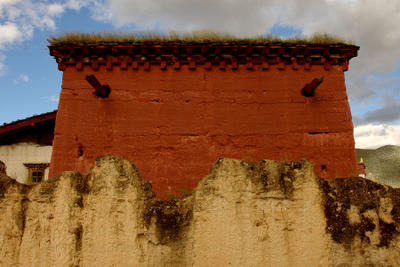
A scene near the living quarters of some monks.
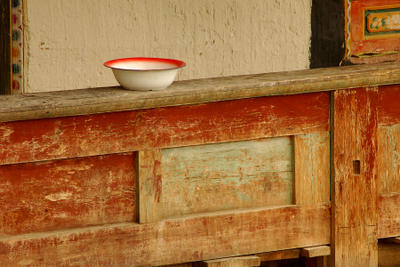
More cooking paraphernalia near the monk's quarters. For monks, as for many of us men, cleaning the dishes after meals is apparently less important than creating aesthetically interesting piles of debris.
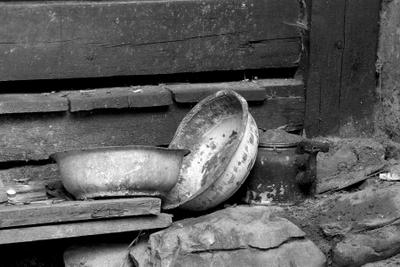
The monasteries are rich in altars as one would predict. Some, like this one, are simple, while others feature elaborate and complex collections of offerings, carvings, textiles and photographs.

This scene was inside a portion of the Ganden Sumtseling Gompa where no women are allowed. That must be because the monks don't want the women to see where all of the golden ladles went. The room was dark and sooty and focused around a wood stove where the monks could relax, secure in the knowledge that if anyone offered them soup, they'd be able to serve it right up.

Noodles are apparently another big part of a monk's diet. These were stacked at Dabao Si, the old monastery further outside of Zhongdian than Ganden Sumtseling Gompa. Are monks typical bachelors? In my youth I ate noodles for hundreds of consecutive meals despite no strong religious affiliation.

I awoke early one morning and walked up a hill behind old town Zhongdian where I discovered a small monastery. I was lucky to be there for the sunrise, and although prayer flag pictures have become trite, the morning light was too pretty to resist. In fact, it was perhaps my nicest experience in Zhongdian--sitting quietly high above town as locals walked up the hill to worship in the morning chill. From below, the sounds of the new city waking up seemed far away and the mountains leading to Tibet on the skyline seemed close.

A worshipper hikes up the hill from new town Zhongdian.
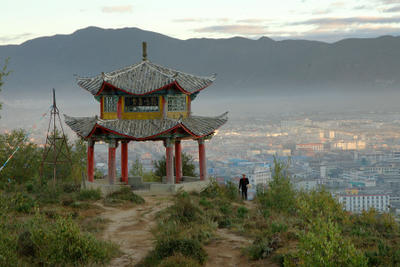
These prayer flags at the Dabao Si (temple) covered a hillside so thickly that one had to stoop and crawl for hundreds of yards to pass beneath them.

Bei makes friends easily. While several of us milled around near Dabao Si talking about lunch options, Bei befriended this kind soul who seemed pleased, if slightly self concious, to have been selected by her.

Tibetan houses feature huge wooden posts and beams. Where they come from is a mystery, since large trees in China seem to have been thoroughly removed. Apparently some can still be found. There was a lot of construction around Zhongdian using posts and beams that were up to a couple of feet in diameter. Bei took a rest on this pile near Dabao Si before we went across the field to see some goats and feed them peanuts.

This little girl was sitting with a crowd of adults near Dabao Si during a lunchtime meeting.
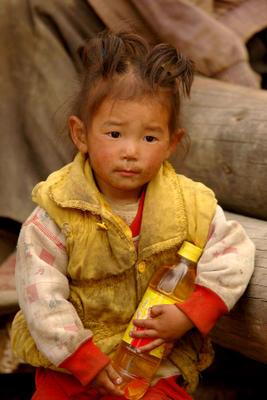
And these three came to see us off as we left in our hired mini-van.
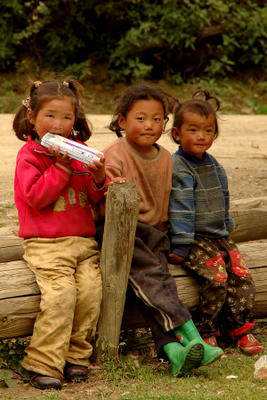
Though evocative of Tibet, the enormous prayer wheel in the center of old town Zhongdian is really just a gaudy tourist attraction. But apparently local Buddhists also like it and climb the hill to spin it using big cables that dangle from the wheel to the ground. Prayer wheels are always spun clockwise (at least here in the northern hemisphere).

Crop drying racks on the outskirts of old town Zhongdian at dawn. It's autumn and these racks are everywhere loaded with root vegetables, corn, and other crops that we can't identify.
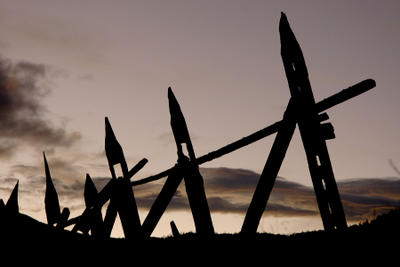
In the Tibetan language our third holiday destination is called Gyelthang. In Chinese it is Zhongdian and, in the language of capitalist tourist-mongers, it has been crowned Shangri La because of it’s alleged proximity to the setting of James Hilton’s novel Lost Horizon. In fact, Shangri La (or Shangri Li La as the locals call it) seems to be migrating south. The Lonely Planet travel guidebook pins the name on the smaller town of Deqin further north and closer to the Tibetan border, but everyone else we’ve talked to both in Lijiang and in Zhongdian itself, affixes the name firmly and officially to Zhongdian.
In any case, Zhongdian (as I’ll call it) has characteristics of all three names. It offers a first taste of Tibet for those of us who have not yet traveled closer to the “autonomous region”: yak carcasses litter the sidewalks and large Buddhist temples occupy the surrounding hills and villages. Zhongdian also has a bustling and nondescript Han Chinese “new town” where concrete and tile buildings line wide, busy streets. Finally, a significant investment in tourism (Shangri La) is evident in the renovated but still small and attractive “old town,” and in new hotels and roads in and around Zhongdian.
Overall, Zhongdian feels more like a frontier town than other places we've been. Sprawl is limited (for now) and there is high, open country all around. Tourism, though certainly significant, has not yet overwhelmed Zhongdian, and as soon as you are outside of the town proper, you are among herders moving yaks and goats through beautiful green valleys and pastures.
We spent a couple of days here and visited a large monastery complex just outside of town (Ganden Sumtseling Gampa), a smaller but older temple (Dabao Si) near a Tibetan village, and a third temple a short walk from our old town guesthouse. And we enjoyed the best chocolate brownies with ice cream that we’ve had since Shanghai. Maybe this really is Shangri La.
The driver collecting bus fare on the ride from Baishuitai to Zhongdian. The cigarette is standard. Bus drivers smoke while they drive, doctors smoke while they examine you, and basketball referees smoke while they run up and down the court, removing their cigarettes only to swerve, make injections or blow their whistles, respectively.

A yak boneyard on a sidewalk in Zhongdian. As one gets closer to Tibet, yaks become a more common menu item and restaurants serving yak pile up the unused parts out front. Some of the displays are much more impressive than this one, but I neglected to get a shot until we were on our way out of town, so I had to settle for a couple of skulls and a backbone. Yak meat is delicious, by the way. And boiled, sweetened yak milk is good in coffee.

The biggest monastery in Zhongdian is just outside of town and apparently resembles the Potala in Llasa. This monastery is called the Ganden Sumtseling Gompa and is occupied by 500 - 600 monks (and overrun by about 6000 tourists, including us). It's a beautiful place (despite the tourists) and it's possible to find hidden corners and stupa courtyards where there are no people. One is left longing to go to Tibet.

A building at the monastery. The grass roofs serve three purposes. First, they symbolize closeness to nature and life; second, they keep animals from climbing into the interior walls and third, they protect the adobe walls from eroding. I'm not entirely sure how a grass roof accomplishes all these things, but that is what we were told.

A scene near the living quarters of some monks.

More cooking paraphernalia near the monk's quarters. For monks, as for many of us men, cleaning the dishes after meals is apparently less important than creating aesthetically interesting piles of debris.

The monasteries are rich in altars as one would predict. Some, like this one, are simple, while others feature elaborate and complex collections of offerings, carvings, textiles and photographs.

This scene was inside a portion of the Ganden Sumtseling Gompa where no women are allowed. That must be because the monks don't want the women to see where all of the golden ladles went. The room was dark and sooty and focused around a wood stove where the monks could relax, secure in the knowledge that if anyone offered them soup, they'd be able to serve it right up.

Noodles are apparently another big part of a monk's diet. These were stacked at Dabao Si, the old monastery further outside of Zhongdian than Ganden Sumtseling Gompa. Are monks typical bachelors? In my youth I ate noodles for hundreds of consecutive meals despite no strong religious affiliation.

I awoke early one morning and walked up a hill behind old town Zhongdian where I discovered a small monastery. I was lucky to be there for the sunrise, and although prayer flag pictures have become trite, the morning light was too pretty to resist. In fact, it was perhaps my nicest experience in Zhongdian--sitting quietly high above town as locals walked up the hill to worship in the morning chill. From below, the sounds of the new city waking up seemed far away and the mountains leading to Tibet on the skyline seemed close.

A worshipper hikes up the hill from new town Zhongdian.

These prayer flags at the Dabao Si (temple) covered a hillside so thickly that one had to stoop and crawl for hundreds of yards to pass beneath them.

Bei makes friends easily. While several of us milled around near Dabao Si talking about lunch options, Bei befriended this kind soul who seemed pleased, if slightly self concious, to have been selected by her.

Tibetan houses feature huge wooden posts and beams. Where they come from is a mystery, since large trees in China seem to have been thoroughly removed. Apparently some can still be found. There was a lot of construction around Zhongdian using posts and beams that were up to a couple of feet in diameter. Bei took a rest on this pile near Dabao Si before we went across the field to see some goats and feed them peanuts.

This little girl was sitting with a crowd of adults near Dabao Si during a lunchtime meeting.

And these three came to see us off as we left in our hired mini-van.

Though evocative of Tibet, the enormous prayer wheel in the center of old town Zhongdian is really just a gaudy tourist attraction. But apparently local Buddhists also like it and climb the hill to spin it using big cables that dangle from the wheel to the ground. Prayer wheels are always spun clockwise (at least here in the northern hemisphere).

Crop drying racks on the outskirts of old town Zhongdian at dawn. It's autumn and these racks are everywhere loaded with root vegetables, corn, and other crops that we can't identify.


0 Comments:
Post a Comment
<< Home